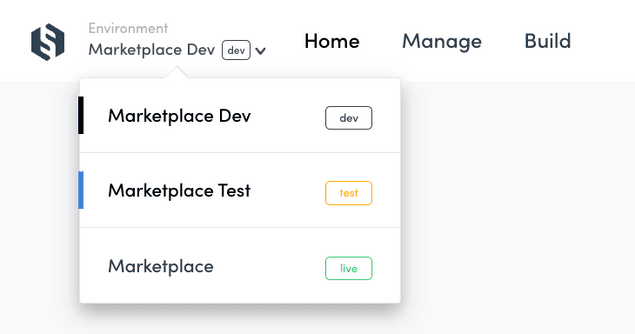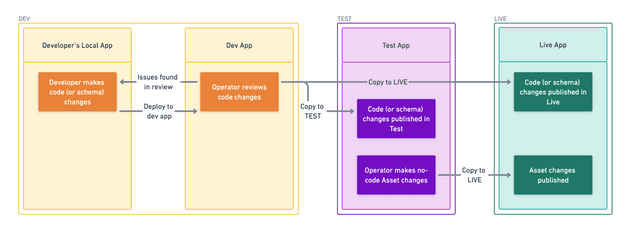Last updated
Flex environments
What are Flex environments and the differences the three types have.
Table of Contents
Flex environments are instances of your own marketplace, but with different functions. When you first create a Flex account, you have two environments: Test and Dev. When you are ready to go live, we will create a third environment: Live.
The environment can be changed from the dropdown in the left corner of the topbar. Those who have access to multiple organizations can see the organization dropdown on the right.
Information
Organization and environment are terms that are used to communicate which Flex marketplace you are looking at in Console.
Organization: An entity that is created when you first create an account. This is where you can invite other admin users to work with. An organization can include multiple environments for different purposes, but it can only include one live environment.
Environment: A marketplace instance within your organization which can be created for different purposes. There are three different types of environments: dev, test, and live. You can access them all with the same Flex account.
Environment types
The three environments in Flex each have their own specific purpose. Each environment should also have its own dedicated client application, which also follows the purpose of the environment.
Dev environment
The dev environment is for development purposes. This is where building your marketplace happens and where you can test the build functionalities in peace by using test users and test credit cards with Stripe.
Even after launching your marketplace, you can continue building new features in Dev without causing disruptions to your test or live marketplaces. Note that you should not onboard real users or listings to Dev, as they cannot be moved into Live.
Test environment
The test environment works as a preview environment for Live. Whereas Dev is meant for the developer to make code changes, Test is meant to reflect your live environment as accurately as possible.
Therefore, whenever the development team wants to publish their code changes, they will test and review them in Dev first, and then copy them to Test and Live at the same time.
The operator can make no-code changes in Test, and copy them to Live without needing the developer to intervene. Because Test and Live are identical, the operator can trust that their changes made in Test show up correctly when published to Live.
Note that you should not onboard real users or listings to Test, as they cannot be moved into Live.
Live environment
The live environment is where the business happens: here you can onboard your real customers and listings, and your customers can make real money transactions.
When the necessary development has been done and your marketplace is ready for onboarding real users, you can initiate the live environment setup from Console. This is also the point when you start paying the Flex subscriptions (see more information about Flex pricing).
Workflow between the three environments
In a nutshell, the workflow between the environments is that changes flow from Dev to Test to Live:
- code changes are made and reviewed in Dev, and get pushed from Dev to Test and Live
- no-code changes are made in Test, and get pushed from Test to Live.
Code changes include
- client application development, updated through your code repository
- transaction process changes, updated through Flex CLI
- search schema changes, updated through Flex CLI
No-code changes include
- Microcopy changes in Flex Console
- Pages changes in Flex Console
We recommend that you keep Test and Live identical as much as possible. In other words, push any code changes from Dev to Test and Live at the same time before making further no-code changes in Test. This will ensure that Test accurately works as a preview environment for Live.
Additional development environments
Depending on your development flow, you might need additional dev environments for your organization, e.g. for Quality Assurance (QA) or automated testing. We can include additional environments to your paid subscription at a price of $49 per month per environment. To include additional development environments in your subscription, contact Flex Support!

